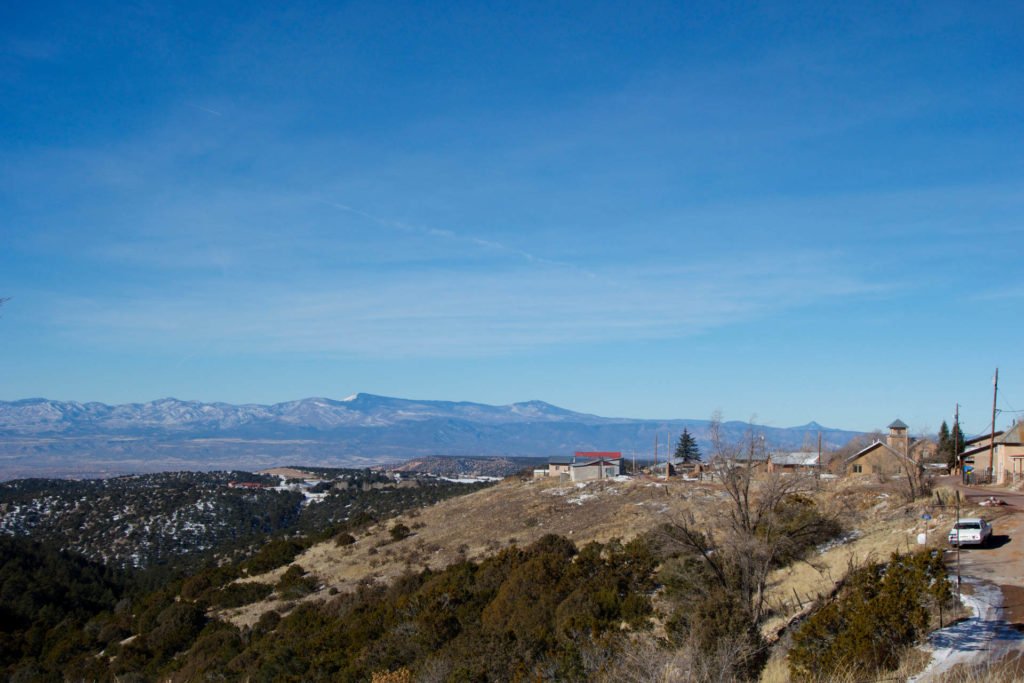
The high road to Taos
It was a crisp January morning the day I drove the high road to Taos, a winding route that threads through the mountains from Santa Fe. Snow was on the ground and the mountains were framed by clear blue skies. Somehow not what I’d expected from New Mexico, perhaps it’s the ‘Mexico’ part that paints a different picture.
As the narrow road climbs higher and higher, it passes through a series of small pueblos that somehow seem to have been transported from the high Andes. Pretty timber and adobe houses, some looking like they have seen better days, sit in clusters along the way. I stopped at the village of Chimayo, famous for its church and chilis. The turn to El Santuario de Chimayo, site of the largest Catholic pilgrimage in America, is down not much more than a muddy lane but like religious sites the world over it is surrounded by little stalls and huts selling everything from religious art to neat bundles of the famed chilis. In the first week of January everything was shut, not a soul to be seen.

A shrine at Santuario de Chimayo
Covered in snow, the little adobe church is unbelievably picturesque. A small arched gate leads into a courtyard with the main church and its two towers that stand on either side. Inside, the wooden beams, terracotta mosaics on the walls and neat rows of little benches paint a pretty picture. A side room is plastered with thousands of photos of pilgrims and strangely multiple rows of crutches hang from wall. There is another alcove, only accessible by ducking through a small four foot archway in the adobe, that leads to a small empty room except for a small hole in the floor filled with soil. It is the healing properties of this earth that attract over 300,000 pilgrims a year to Chimayo. Alone in the church, I rubbed a little on my dodgy knee.
From Chimayo the high road to Taos continues its ascent, passing through stands of juniper and pine, with incredible views looking back towards the Rio Grande valley far below, snow-capped peaks in the distance. Truchas is the next pueblo, founded by the Spanish in 1754. Perched on the edge of a ridge at over 8,000 ft and with smoke drifting from its chimneys, it is quite a sight on a snowy morning. All of these villages are known for their craftsmanship and Truchas is no different with handpainted signs every so often advertising an artist’s gallery, weavings for sale or a tinsmith’s studio.

The view from Truchas looking towards the Rio Grande valley
With its simple buildings, potholed road and not a person in sight, there is an air of timelessness in Truchas. I later found out that the road and electricity were only installed in the 1970s. Driving through the pueblo I glimpsed the small church between two buildings, known for its precious wood carvings. The houses thin out and small farms dot the fields, huge piles of wood stacked under the eaves and big adobe hornos sit outside covered in a layer of snow. The only people I see pass in a beaten old pickup.

Looking out across the Carson National Forest
Continuing to Taos the road passes another beautiful Spanish church in Las Trampas, San Jose de Gracia built in 1760. Just after the Indian Reservation at Picuris, the scenery becomes almost alpine with small farms and houses running along the valley floor. On an empty stretch of road I stopped at a roadside restroom, as I turned to leave I noticed that the door was peppered with bullet holes. Friday night entertainment in the mountains. The final stretch before eventually dropping down to Taos runs through a stunning section of the Carson National Forest, 1.5 million acres of pinyon pine, juniper and fir that blankets this area of New Mexico.
